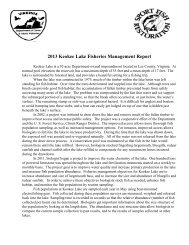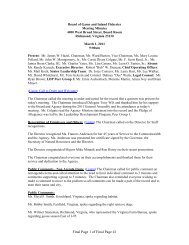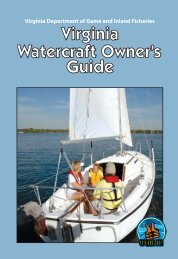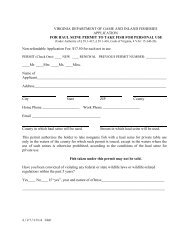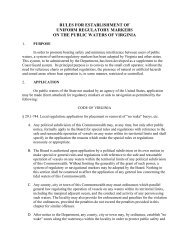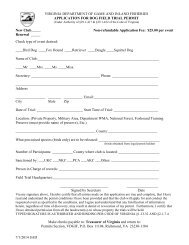2013 Virginia Freshwater Fishing & Watercraft Owner's Guide
2013 Virginia Freshwater Fishing & Watercraft Owner's Guide
2013 Virginia Freshwater Fishing & Watercraft Owner's Guide
Create successful ePaper yourself
Turn your PDF publications into a flip-book with our unique Google optimized e-Paper software.
<strong>2013</strong> <strong>Fishing</strong> Regs & WOG 11-15-12_Layout 1 11/16/12 1:02 PM Page 56Type I–AdultType I–HybridType II–ChildType III–AdultInflatable life jackets may be aType III or Type V, check the label.Type IV Throwable Ring Buoy & Seat CushionLife jacket photos by Dwight Dykeseat cushion), on vessels of 16 feet orgreater. The regulation to carry a Type IVdoes not apply to (1) personal watercraft;(2) non-motorized canoes and kayaks of16 feet or greater; (3) racing shells,rowing sculls, racing canoes, and racingkayaks; (4) sailboards; and (5) vessels ofthe United States used by foreigncompetitors while practicing for orracing in competition.D Each Type IV throwable must beimmediately available. “Immediatelyavailable” means the life jacket shallbe quickly reachable in an emergencysituation. An immediately availablelife jacket cannot be in a protectivecovering, in a closed compartment orunder other equipment. There is norequirement to have a line attached.• All life jackets must be in good andserviceable condition. A life jacket thatdisplays any of the following is not ingood condition:D Metal or plastic hardware used tosecure the life jacket on thewearer that is broken, deformed, orweakened by corrosion;D Webbings or straps used to secure thelife jacket on the wearer that areripped, torn, or which have becomeseparated from an attachment pointon the life jacket; orD Any other rotted or deterioratedstructural component that fails whentugged.D Rips, tears, or open seams in fabric orcoatings, that are large enough toallow the loss of buoyant material;D Buoyant material that has becomehardened, non-resilient, permanentlycompressed, waterlogged, oil-soaked,or which shows evidence of fungus ormildew; orD Loss of buoyant material or buoyantmaterial that is not securely held inposition.• Inflatable Life Jackets must meet all therequirements for life jackets listed aboveplus the following:D A properly armed inflation mechanism,complete with a full inflationcartridge and all status indicatorsshowing that the inflation mechanismis properly armedD Inflatable chambers that are allcapable of holding air;D Oral inflation tubes that are notblocked, detached, or brokenD Inflation status indicators that are notbroken or otherwise non-functionalD The inflation system of an inflatablelife jacket need not be armed whenthe life jacket is worn inflated andotherwise meets the requirementsabove.• Federal Life Jacket Rule for ChildrenUnder 13 Years Old—No person mayoperate a recreational vessel on federalwaters with any child under age 13 onthe vessel unless each child is either:D Wearing an appropriate life jacketapproved by the Coast Guard; orD Below deck or in an enclosed cabin.In <strong>Virginia</strong>, this rule is enforced by the U.S.Coast Guard or other federal agents andapplies on waters over which they haveenforcement jurisdiction. Most waters in<strong>Virginia</strong> are considered federal waters.A Special Note about InflatableLife JacketsInflatable life jackets are lightweight, comfortableto wear and take up about one-tenththe storage room of conventional foam-filledlife jackets. Most are USCG approved only forpersons 16 years of age and older who arenot engaged in white water or skiing activitiesor riding on PWC. They are a great choice foradults on the water!Does Your Life Jacket Really Fit?How do you know if a life jacket really fitsyou? First, check the label to make sure thelife jacket is a U.S. Coast Guard approvedwearable. Life jackets (or PFDs) come in acouple of basic sizes: infant, child, and adult.Within those basic sizes, there will be a range(Small, Medium, Large, etc.) of sizes. Thelabel will indicate the basic size and the sizerange, which will include a weight range andusually also a chest size range. After youcheck the label, make sure you move on tothe second step, try it on! Before every boatingseason, try on your life jacket. Make surethat it fits correctly. What does a correct fitmean? It should be snug, but not tight. Liftyour arms over your head, can you turn yourhead left, right, and over your shoulder orhas the life jacket ridden up and is in the wayof moving your head? For a child, have themstand with their arms to their sides. Lift thelife jacket up by the shoulders. The life jacketshould not move more than 3 inches, nohigher than the child’s ears. If the life jacketdoes move up more than 3 inches, it is toobig and the child can slip right out—get asmaller life jacket! A younger child’s life jacketshould also include a crotch strap—thiswill help insure the life jacket stays on. Finally,practice using the life jacket in shallowwater. Make sure it is snug enough to stayput and not ride up over the chin and earswhen in shallow water. Have children practicein shallow water with their life jacket sothey don’t panic in case of emergency.Fire ExtinguishersAll boats over 26 feet must have USCGapproved, adequately charges fire extinguishersaboard (see the chart on page 57for specific safety requirement). In addition,all motorboats under 26 feet that have oneor more of the following conditions mustalso carry fire extinguishers:a. Permanently installed fuel tanks.b. Closed compartment under thwarts andseats wherein portable fuel tanks maybe stored.c. Double bottoms not sealed to the hull orwhich are not completely filled withflotation material.d. Closed living spacese. Closed stowage compartment in whichcombustible or flammable materialsmay be stowed.All fire extinguishers must be U.S. CoastGuard approved, must have an efficientchange, and must be in good and service -able condition.Backfire Flame ArrestorInboard gasoline engines must have USCG,SEA, or UL approved flame arrestors on their56<strong>2013</strong> <strong>Virginia</strong> <strong>Freshwater</strong> <strong>Fishing</strong> & Boating <strong>Guide</strong>



